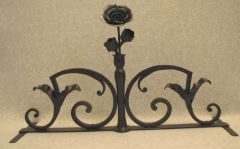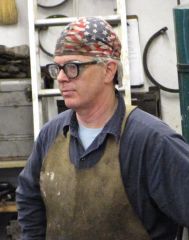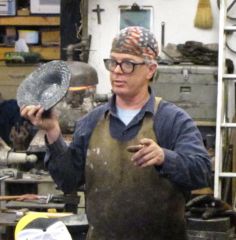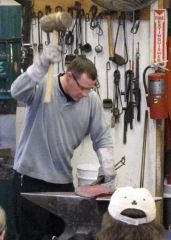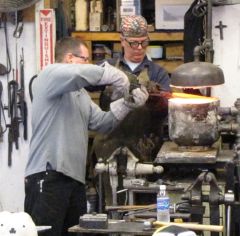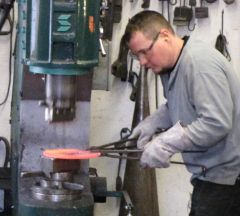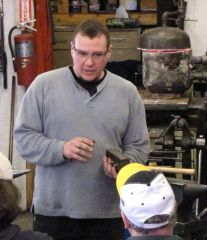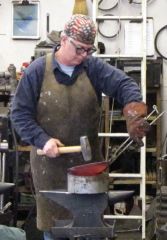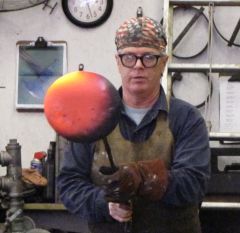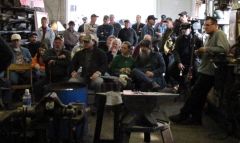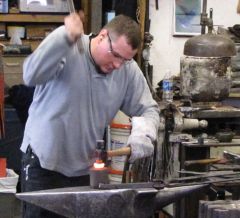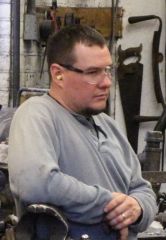-
Posts
312 -
Joined
-
Last visited
Content Type
Profiles
Forums
Articles
Gallery
Downloads
Events
Everything posted by Jymm Hoffman
-
When I was burning coal, I switched over to the side blast forge (not draft, I used a side draft chimney.) I eventually made a water cooled tuyre (the pipe leading into the fire, not that clinker breaker in a bottom blast forge.) I was burning up pipe until I made a water cooled tuyere. I simply made a tank for holding the water and made the tuyre out of 1" and 1 1/4" pipe, welding the end and making a jacket for the water to flow from the tank into the larger pipe. It was not as complicated as the link. In mine the larger pipe was welded to the tank and at the fire end of the 1" pipe. The 1" pipe went through the tank, welded on the back side where the blower was attached and also at the fire end with the other pipe to form the inside of the jacketed tuyre. I preferred this over the fire pot. I always knew where the clinker was and there was less wasted fuel as it could not fall through a grate or clinker breaker. The tuyre was long enough for the tank to sit behind the chimney and come out into the fire an inch or so. I just made certain it the fire end was slightly below level for the water to flow. But after switching to propane, I did not worry about these matters for daily use.
-
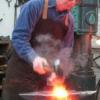
Nails, oh wonderful nails.
Jymm Hoffman replied to SRT02's topic in Blacksmithing, General Discussion
Shanks should be retangular not a square taper. Square tapers are wedges that split the wood. Put the wide side so it cuts the grain. If you are still splitting, then pilot drill the holes. -
Some times it is best if I walk away from a project. Either because I am tired, close to messing it up or it is fighting me.
-
You left out some important information. It is illegal to burn bituminous coal in Allegheny County, PA. Just because you live in PA does not mean you can get your hands on good coal. Many places have some local coal, but it is junk. Free and cheap is not always better. The really good stuff is normally scarfed up by big companies leaving us little guys to suck wind hoping for droppings. After having been violently sick from bad coal, spending many hours driving for half way decent coal, blowing black snot out of my nose, coughing like a smoker, brushing coal dust out of my hair, dragging coal dust into the house, and 13 years of full time use of mostly bituminous coal, tried coke and anthracite, spent a lot of time cleaning clinker and ash from the fire, the romance finally left me and I finally switched to propane. No pick up or delivery time, no storage problems, no need to carry the fuel into the shop then take out the ashes to either spread on the driveway or put into the trash, black buggers gone (except from grinding which is easily remedied with a dust mask,) and a lot less coughing. Much healthier with the switch. In the warmer weather, I think an awful lot about induction. So do you want to just play with a fire or do you want to spend more time making neat stuff? Time for me to heat it and beat it, not play with a fire.
-

Forge Fuel Consumption
Jymm Hoffman replied to Blacksmith Jim's topic in Blacksmithing, General Discussion
I was using about 3 to 4 tons of coal a year in the early 1990's. I switched to propane in 1993. Not what my consumption of propane was, but my production increased drastically, as well as sales because I had more stuff to sell. I have not burned coal in my shop since. Last summer I did a pre-buy and payments on a monthly budget. Just paid the last $300.00 payment (10 months.) I went through my 1,000 gallons and will set up another pre- buy of at least 1,000 to 1,200 gallons. Price is dropping for propane finally. It will probably cost me around $2.25 to $2.50 per gallon. Propane did not do well on the pre-buy system this time, normally it is way ahead of the game. I have bee seriously considering Grant's induction machine, for at least summer work. My forge heats my shop nicely, all year round. However, there are some things that the propane will do better than the induction, especially when I am teaching students in the winter time. -

Selling/ shipping heavy stuff
Jymm Hoffman replied to Ferrous Beuler's topic in Anvils, Swage Blocks, and Mandrels
Depends on the weight. UPS will take up to 150 pounds. I followed someone else's advice and have good success. I use banding (because I have it and the tools,) to strap a board on the top and on the bottom. I cut the boards to tracing marks from the anvil. I also use a Sharpie to write the to and from addresses on the face of the anvil incase this comes off the anvil. I staple the UPS label on the top board, then shrink wrap them. I use some packing tape to re-enforce the shrink wrap and to help keep it from coming undone. My UPS driver says they prefer these wrapped this way, easier to move than if they were in a box and they won't poke through since they are not in a box. Over 150 pounds, I use R&L Carriers : R+L Carriers Depending on weight, location etc. You may have to take to the terminal. R&L does not charge for a lift gate as many other carriers do. UPS also does freight now, they bought out Overnight Express. Both will pick up and deliver to some residential areas. I use the banding strap to strap the anvils to a small pallet and use very similar techniques as above. -
I have one double horn anvil and one Colonial Pattern anvil in stock. Hoffmans Forge, LLC - Anvils for sale
-

Tire or helve hammer??????
Jymm Hoffman replied to hammerkid's topic in Power Hammers, Treadle Hammers, Olivers
air hammer. bigger opening for tooling. -
HW, I don't think you have enough pressure from your blower, maybe the burner tip configuration being different as well. To get enough pressure, most blowers need to run at 3,450 rpms or more. Volume alone is not enough as well as pressure alone, you need both, but can easliy over do it with some blowers on the market. Tasmith, You are absolutely correct. The problem I have is finding such a new blower at a reasonably low price. I was actually reluctant to try the ones I now recommend for the reasons you mention. However, these blowers are not your average squirrel cage, and since I wanted a readily available source at what I call a more reasonable price, I tried the ones from Kayne & Son/Blacksmiths Depot. I was getting prices of over $500.00 for new paddle type blowers and the manufacturers wanted to sell large volumes. Now if you can get a used one from a Johnson Furnace, you will get a great blower. I just checked the prices of the blower I would recommend from Johnson is $785.00 compared to Blacksmith's Depot for about $110.00. And as Paul Harvey would say, and now you know the rest of the story, at least why I use these blowers.
-
Barbecue regulator set at house hold pressure is 11 inches of water column, that is about 1/2 pound pressure. Pretty much what I was going to send you is in the link that Chris posted. One of the photos shows a needle valve, it was used for fine adjustment. It has been removed because it would change on me and I had to constantly adjust it. Went back to just using the ball valve for adjustments in the gas.
-

help with Pintles / wrapped & welded
Jymm Hoffman replied to Don A's topic in Blacksmithing, General Discussion
Don, Great drawings. I can not always get the gap to disappear, but frequently do with the following method: I add a step, after the shoulder and scarf, bend away from the shoulder and upset the corner a little. Then wrap back around, also helps to get the pin started on center. Do not close up completely, as welding a collar around a bar. I frequently make the welds diamond shape instead of round, as some of the originals. After you get a good weld, you can then knock the corners out (at a welding heat,) to make the part the hinge rides on round. Doing a batch of pintles this way now. -
You have not tried one of my anvils, or any of the other new ones that are made from tool steel. Mine are cast, yes but entirely of H13 tool steel and through hardened, horn is just as hard as the face, the feet are just as hard as well. They do bounce the hammer back as well or better than my 150 year old Peter Wright. You may have experience with some cheap cast iron anvils, not the quality cast steel ones now on the market.
-

2009 PAABA Hammer In at Hoffman's Forge, LLC
Jymm Hoffman posted a gallery image in PAABA Hoffman\'s Forge Hammer In
-

2009 PAABA Hammer In at Hoffman's Forge, LLC
Jymm Hoffman posted a gallery image in PAABA Hoffman\'s Forge Hammer In
-

2009 PAABA Hammer In at Hoffman's Forge, LLC
Jymm Hoffman posted a gallery image in PAABA Hoffman\'s Forge Hammer In
-

2009 PAABA Hammer In at Hoffman's Forge, LLC
Jymm Hoffman posted a gallery image in PAABA Hoffman\'s Forge Hammer In
-

2009 PAABA Hammer In at Hoffman's Forge, LLC
Jymm Hoffman posted a gallery image in PAABA Hoffman\'s Forge Hammer In
-

2009 PAABA Hammer In at Hoffman's Forge, LLC
Jymm Hoffman posted a gallery image in PAABA Hoffman\'s Forge Hammer In
-

2009 PAABA Hammer In at Hoffman's Forge, LLC
Jymm Hoffman posted a gallery image in PAABA Hoffman\'s Forge Hammer In
-

2009 PAABA Hammer In at Hoffman's Forge, LLC
Jymm Hoffman posted a gallery image in PAABA Hoffman\'s Forge Hammer In
-

2009 PAABA Hammer In at Hoffman's Forge, LLC
Jymm Hoffman posted a gallery image in PAABA Hoffman\'s Forge Hammer In
-

2009 PAABA Hammer In at Hoffman's Forge, LLC
Jymm Hoffman posted a gallery image in PAABA Hoffman\'s Forge Hammer In
-

2009 PAABA Hammer In at Hoffman's Forge, LLC
Jymm Hoffman posted a gallery image in PAABA Hoffman\'s Forge Hammer In
-

2009 PAABA Hammer In at Hoffman's Forge, LLC
Jymm Hoffman posted a gallery image in PAABA Hoffman\'s Forge Hammer In

